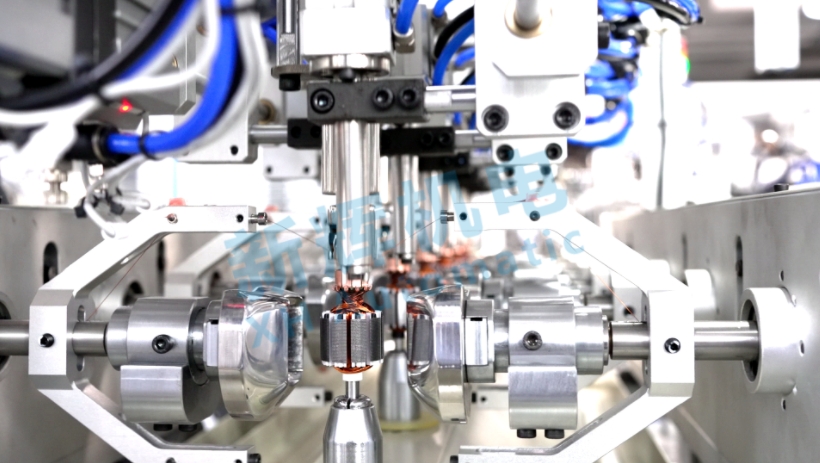What are the common sensor failures and their solutions for motor motor rotor manual six-station double flying fork winding machine?
Motor motor rotor manual six-station double flying fork winding machine common sensor failures and solutions are as follows:
1、Position sensor failure
Failure phenomenon: the winding position is inaccurate, the line may wind to the place where it should not be wound, resulting in the rotor winding does not meet the requirements; flying fork or other parts of the movement position does not match with the expected, affecting the normal winding.
Possible reasons: the sensor is loosely installed, resulting in deviation of the detection position; the sensor is contaminated by dust, oil and other contaminants, affecting the accurate transmission of signals; the sensor itself is damaged and cannot work properly.
Solution: Check the installation of the sensor, if loose, then re-tighten; clean the sensor surface of dust and oil, to ensure that the signal transmission is normal; the use of professional instruments to detect the sensor, such as determining the damage is replaced with a new sensor .

2、Tension sensor failure
Failure phenomenon: unstable winding tension, inconsistent tension of the line, which may lead to the line package is not tight or the line is pulled off; tension control system can not be based on the actual situation for effective tension adjustment.
Possible causes: deviation in the calibration of the tension sensor, resulting in inaccurate measurement values; poor contact of the sensor's signal wire, affecting the signal transmission; aging or damage to the tension sensor, which can not normally sense the tension changes.
Solution: recalibrate the tension sensor to ensure that its measurement is accurate; check the connection of the signal line, if loose or poor contact repair; replace the aging or damaged tension sensor.
3, counting sensor failure
Failure phenomenon: the number of winding turns is inaccurate, inconsistent with the set number of turns, affecting the electrical performance of the motor rotor; counter can not be counted properly or counting errors, resulting in inaccurate data recording in the production process.
Possible causes: the counting sensor sensing parts are damaged, unable to accurately detect the number of turns of the winding; communication failure between the sensor and the controller, resulting in counting signals can not be transmitted normally; counting sensor setup parameters are wrong, and the actual winding does not match the situation.
Solution: Replace the damaged inductive parts of the counting sensor; check the communication line between the sensor and the controller, and repair the communication failure; check and reset the parameters of the counting sensor, so that it matches the requirements of the winding process.
4、Speed sensor failure
Failure phenomenon: the running speed of the winding machine is unstable, sometimes fast and sometimes slow, affecting the quality and efficiency of the winding; speed display is inaccurate, can not correctly reflect the actual running speed of the winding machine.
Possible causes: the probe of the speed sensor is worn or damaged, resulting in inaccuracy of the detected speed signal; the sensor is installed in an improper position, affecting the collection of signals; the circuit of the speed sensor is faulty, resulting in abnormal signal processing.
Solution: Replace the worn or damaged speed sensor probe; adjust the installation position of the sensor to ensure that the speed signal can be accurately collected; check the speed sensor circuit, repair or replace the faulty electronic components .
5、Proximity sensor failure
Failure phenomenon: in need of proximity detection of the movement of components, such as ear protection devices, fixtures, etc., can not accurately detect the proximity of the components of the state, resulting in the corresponding action can not be accurately executed in a timely manner; proximity sensors inaccurate operation, so that the equipment has an abnormal pause or incorrect operation.
Possible reasons: the sensing distance of the proximity sensor is set unreasonably, and the actual distance of the movement of the components does not match; the sensor is subjected to external interference, such as electromagnetic interference, etc., which affects the normal detection of signals; proximity sensors themselves quality problems or aging damage.
Solution: According to the actual movement of the components, re-adjust the proximity sensor sensing distance; take effective anti-interference measures, such as shielding sources of interference, the use of filters, etc., to reduce the impact of external interference on the sensor; replacement of reliable quality proximity sensors or sensors that have been damaged by aging.
※ If the above ways and means still can not solve the equipment failure, please contact Xinhui Electromechanical Equipment Co., Ltd. through the page chat tool to seek help.







